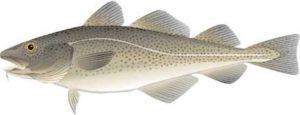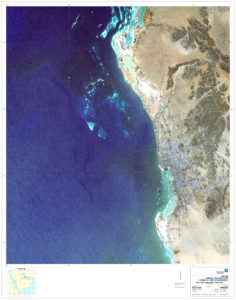Projects
FATE: Predictors for larval cod recruitment
James Churchill (WHOI), Jeffery Runge (Univ. Maine), Jim Manning (NOAA/NMFS) and Loretta O’Brien (NOAA/NMFS)
FATE: Predictors for larval cod recruitment
A project funded through NOAA's Fisheries and the Environment program. The overall goal is to develop a better understanding, and predictive capability, of year-1 recruitment to western Gulf of Maine Atlantic cod stock.
Approach
Our approach is to use velocity fields generated by a hydrodynamic models of the Gulf of Maine/Georges Bank region to simulate the movement of cod eggs and larvae and to determine the likelihood that the developing cod arrive at areas suitable for settlement as young juveniles. The model velocities employed thus far were supplied by the Marine Ecosystem Dynamics Modeling group at U. Mass. Dartmouth (courtesy of C. Chen) and were generated by the FVCOM Gulf of Maine/Georges Bank model (http://fvcom.smast.umassd.edu/FVCOM/index.html). So that our ability to predict larval cod transport in future years will not be compromised should this set of model results become unavailable, we are also developing code to carry out the larval transport simulations using velocity fields generated by other Gulf of Maine models. Currently, our focus is on the velocity fields generated by the Gulf of Maine Ocean Observing System (GoMOOS) nowcast/forecast model. These fields are updated continually and are publically available online through the Gulf of Maine Ocean Data Partnership. We are developing user-friendly, MATLAB-based software to utilize model data served through the Gulf of Maine Ocean Data Partnership in simulating larval movement in the Gulf of Maine Georges Bank region. We will make this available to the user community through this site and the site for the Gulf of Maine Ocean Data Partnership.
Read more
Findings
Although cod spawning may occur intermittently in the western Gulf of Maine throughout the year, the appearance of large spawning aggregations in the western gulf is confined to winter and spring “spawning events”. Winter spawning typically extends from November through February and is broadly distributed over the western gulf. Spawning in the spring is concentrated in the area of Ipswich Bay and near Cape Ann. The most intensive spawning of the spring event extends over April through June, with peak activity tending to occur in May.
The results of our analysis indicate that the conditions during spring often favor the retention of cod eggs and larvae within the western Gulf of Maine. The tendency for retention is most strongly tied with the alongshore wind. Cod eggs released from spawning sites during a time of predominately upwelling favorable winds tend to be flushed out of the western Gulf of Maine, as the upwelling circulation carries the developing eggs (presumed to reside in the surface mixed layer) to the Western Maine Coastal Current. Despite its name, this current is typically centered near the 100-m isobath and bypasses cod spawning and nursery areas in Ipswich and Massachusetts Bays. Cod eggs and larvae that are transported to the Western Maine Coastal Current by upwelling circulation are rapidly transported out of the western Gulf of Maine. This is in contrast with the fate of cod released from coastal spawning areas during a time of predominately downwelling favorable along-shore winds. These cod tend to be carried onshore and successfully transported to juvenile habitats in Massachusetts and Ipswich Bay.
Thetendency for downwelling circulation to favor retention of cod spawned in the western Gulf of Maine during spring is reflected in the correlation of the wind with yearly values of recruitment success to the age-1 cod population in the Gulf of Maine, compiled by the National Marine Fisheries Service since 1982. Recruitment success is strongly correlated with mean along-shore wind of May, such that the success is higher when the mean May windis are more strongly downwelling favorable. The mean alongshore wind velocity measured in Massachusetts Bay during May may thus be viewed as a robust indicator for the recruitment success of age-1 cod to the Gulf of Maine cod stock, roughly 90 % of which is contained in the western Gulf of Maine.
Further details of our analysis and findings are contained in the publications listed below.
Publications:
Churchill, J.H. and J. Runge (2009) What Maintains the Western Gulf of Maine Cod Stock? Proceedings of a workshop on Exploring Fine-scale Ecology for Groundfish in the Gulf of Maine and Georges Bank, 2-3 April 2009, York, Maine, 8 pp.
Churchill, J.H., J. Runge and C. Chen, Processes controlling retention of spring-spawned Atlantic cod in the western Gulf of Maine and their relationship to an index of recruitment success. submitted to Fisheries Oceanography.
Runge, J.A. et al., Understanding Climate Impacts on Recruitment and Spatial Dynamics of Atlantic Cod in the Gulf of Maine: Integration of Observations and Modeling. submitted to The Proceeding of the Gulf of Maine Science Symposium.
Presentations:
Churchill, J.H and J.A. Runge, What Maintains the Western Gulf of Maine Cod Stock? Workshop on Exploring Fine-scale Ecology for Groundfish in the Gulf of Maine and Georges Bank, York, Maine, 2-3 April 2009.
Churchill, J.H., Modeling larval cod transport and recruitment. Coastal Ocean Fluid Dynamics Laboratory seminar, 22 May 2009.
Runge, J.A., A. Kovach, R. Jones, S. Tallack, J.Churchill, C. Chen, G. Sherwood, H. Howell, J. Grabowski and D.Berlinsky, Understanding climate impacts on the spatial dynamics of Atlantic cod in coastal waters of the Gulf of Maine.ICES Cod and Climate Workshop at the GLOBEC Open Sciences Meeting, Victoria, BC, June 2009.
Related Links
» FATE: Fisheries and the Environment
» Exploring Fine-Scale Ecology for Groundfish in the Gulf of Maine and Georges Bank Workshop, York Maine, April 2009
» Gulf of Maine Model Interoperability Pilot Project
Related Files
» Article submitted to Fisheries Oceanography
» Fate 2009 Annual Report
» Power point presentation at FATE Investigators in Seattle, Sept 2009
» Article submitted to The Proceedings of the Gulf of Maine Science Symposium
A measurement and modeling study of waves and currents in the coastal zone off southeastern Massachusetts
Jim Churchill (WHOI) and Geoff Cowles (U. Mass. Dartmouth)
A Woods Hole Sea Grant project
Funded by WHOI Sea Grant, this project is aimed at better understanding, and modeling, the dynamics of surface waves within the coastal waters of Massachusetts. Its linked observational and modeling components have thus far been concentrated on wind-driven current and wave generation in Buzzards Bay. The project website is maintained by co-PI Geoff Cowles at the Univ. of Massachusetts at Dartmouth, and can be accessed by clicking here.
Related File
» Paper presented at IEEE Oceans 09 in Bremen Germany
Tidal Kinetic Energy Resource off the Massachusetts Coast
G. Cowles (U. Mass Dartmouth) and J. Churchill (WHOI)
With funding from MIT Sea Grant, our aims in this project are to assess the potential of tidal energy extraction in the Massachusetts coastal zone and to evaluate the impact of energy extraction on the local environment. The project website is maintained by co-PI Geoff Cowles at the Univ. of Massachusetts at Dartmouth, and can be accessed by clicking here.
KAUST - Coastal and Reef Dynamics in the Red Sea
Steve Lentz (WHOI) and Jim Churchill (WHOI)
Related File
» Summary of Oct. 2008 field work

